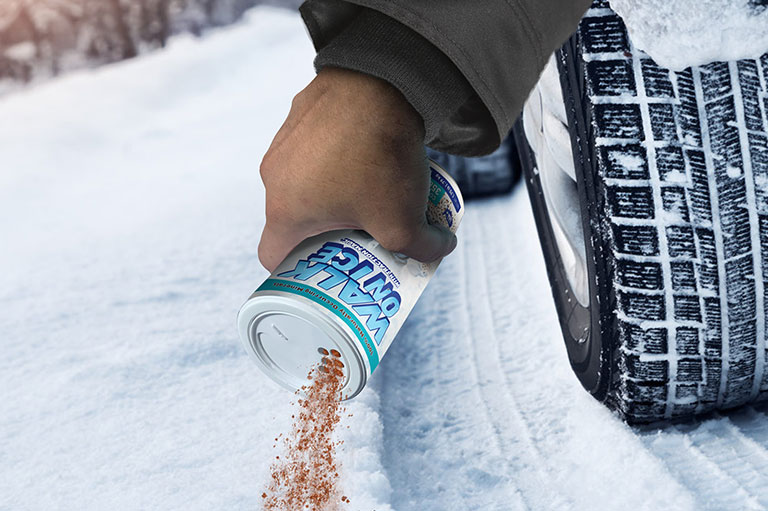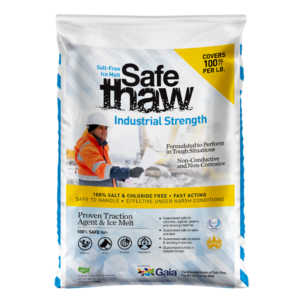All The Ways To Use Walk On Ice

When we think about winter, the next thing that strikes our mind is snow. The beautiful white layer of snow may look ravishing but can cause serious accidents.
But if this incident happens on your premises, you may be subject to a personal injury lawsuit. To protect yourself from such liabilities, it is critical to avoid slip-and-fall claims. You, your family, and your visitors can now walk on ice and snow. There are multiple ways by which you can achieve it and, the most popular being using anti-slip traction agent around your house and premises.
Let’s First Understand Why We Fall-
It’s not the ice because of which we fall. Yes, the reality is, we slip because of the thin layer of free water at the surface of the ice. This layer of water is always present irrespective of what the temperature is. The loosely bonded molecules of water make the surface slippery. Therefore, the underlying reason why we slip on icy surfaces or car tires skid is the lack of friction or natural traction.
The Art of Walking On Icy Surfaces
When you have to walk on ice, it’s best to use small, shuffling steps and to widen your stance, similar to how a penguin walks. This technique helps to distribute your weight more evenly, reducing the chances of falling. Moreover, it’s recommended to keep your hands out of your pockets for better balance and to soften your landing should you slip.
What Is Walk On Ice, And How It Works?
Walk on Ice is a traction agent that has 100% natural ingredients in its blend. This product is a blend of natural volcanic rock and seven other minerals which are safe for everyone and can be reused. These geo crystals are gathered from mines and then processed to produce the product. Different crystals are selected to maximize the absorption of the free water. These different-sized crystals bury themselves into the ice and create the “sandpaper effect” representing a non-slip surface. The non-toxic natural traction agent is safe for children, pets, plants, and the environment and allows you to walk on ice and snow.
In this article, we will understand the different ways in which we can use this product.
Boost Your Traction With Walk On Ice
While it’s important to learn the proper way to walk on icy surfaces, using a high-quality traction agent like ‘Walk On Ice’ can significantly enhance safety. This product is a game-changer in the world of ice management, offering an effective and safer alternative to traditional methods like sand or kitty litter.
Walk On Ice can be conveniently carried in a disposable canister and offers instant traction on icy surfaces, creating an immediate, skid-free, and slip-free surface. Ideal for sidewalks, steps, and driveways, Walk On Ice ensures safety for foot, pet, and car traffic. Plus, it’s safe on all surfaces, including decking, new concrete, and pavers.
Get ready for winter with Walk On Ice instant traction on snow and ice
Walk On Ice Is Particularly Helpful In Cases-
- When you’re stuck in the snow: Vehicles that skid on the ice have more significant repercussions than individuals who slide on the ice. Because of its convenient size, it’s perfect to store in a glove compartment. Simply rub it on and around your tires, and your car is free.
- When you need to access your walkway and reach the car: Ice melt does not serve the need for people to cross the icy or snowy surface immediately. Walk on Ice allows you to do that. Simply pull it out from your purse, spray it on your path, and now you can walk on ice without slipping.
- When your kids want to play in the backyard: Snowfall days can be really gloomy especially for kids as they can’t go out to play. Now you can make your backyard accessible to them for playing without having to shovel away the snow with the walk on ice.
The walk on ice solves your problem of slip and fall and keeps your concrete safe. Not only does it provide a safe environment for your family, but it’s safe for the environment too.
Tackling Slippery Wooden Stairs The Right Way
Even if your driveway and walkways are safe, wooden stairs need anti slip protection. Unlike concrete, wood can absorb moisture and refreeze quickly, creating invisible slick patches. Many homeowners try quick fixes like mats or salt, but these either wear down the wood or create messes that track indoors.
A better approach is layering prevention and traction. Adding rubberized stair grips or adhesive stair treads gives the steps a permanent base of friction. On top of that, using Walk On Ice provides immediate traction whenever snow or ice builds up. Unlike sand or salt, it won’t grind into the wood or corrode nails and screws. So next time freezing rain hits, a quick sprinkle means you won’t dread going up and down your porch stairs.
Walking On Snow And Ice: Beyond The Basics
We all know the “penguin walk” trick—short, flat steps with your weight slightly forward. But safe walking on snow and ice goes beyond posture. For example, planning your route is just as important. Shaded areas freeze first and thaw last, and wet-looking pavement is often hiding black ice. If you carry groceries or packages, keeping one hand free gives you balance and a chance to brace yourself if you slip.
Traction tools add another layer of security. While cleats or grips on shoes help, they’re not always practical indoors. That’s where surface solutions like Walk On Ice shine—turning hazardous paths into reliable walkways. When combined with mindful movement, you’re not just reacting to ice—you’re proactively controlling your environment.
When Your Car Is Stuck In Ice Or Snow
One of the most stressful winter moments is realizing your tires are spinning endlessly because the car is frozen in place. Many people immediately wonder: “What should I do if my car is stuck in ice?” The old-school advice usually involves kitty litter, cardboard, or even floor mats under your tires. But the truth is, these methods are hit or miss.
Does kitty litter help you get out of snow? Sometimes. It offers a bit of grit, but it clumps when wet and can actually harden into slick mud when the temperature drops again. Floor mats may give you one attempt, but if they slide out, you’re back where you started. Walk On Ice, however, was designed for exactly this situation. Its absorber granules remove the water layer on the ice, and the grippers create a sandpaper-like texture for your tires. That means instead of spinning out, your car gains traction right away, saving time, frustration, and even tow truck costs.
Why Walk On Ice Beats Traditional Quick Fixes
Salt, sand, and kitty litter are often the first things people reach for when battling ice. But let’s break down the pros and cons:
- Sand works temporarily but scatters quickly and clogs drains.
- Salt melts slowly, can refreeze, and damages both surfaces and vegetation.
- Kitty litter creates a mess and often isn’t effective once soaked.
Walk On Ice, on the other hand, isn’t about melting—it’s about traction. That’s why it works instantly. For wooden stairs, icy sidewalks, or even a car stuck in ice, it gives you reliable footing without cleanup headaches or long wait times.
Conclusion: Smart Layers Of Safety For Every Winter Surface
Looking back, we’ve moved well beyond the idea of “just throw some salt on it.” Winter safety isn’t about one magic fix—it’s about layering solutions for different surfaces and situations. Wooden stairs need anti slip treads combined with Walk On Ice for extra grip. For walking on snow and ice, it’s posture, planning, and traction agents together. When your car is stuck in ice, you now know that kitty litter is more of a myth than a solution—Walk On Ice provides the reliable traction you need.
So the next time winter throws its icy challenges your way, you won’t be caught off guard. You’ll have the right mix of preparation, tools, and knowledge to handle anything—from slippery porches to frozen driveways and snow-packed tires. Walk On Ice doesn’t replace safe habits, but it complements them, ensuring that your home, family, and even your car are protected.
FAQs
Other Ice Melt Products
Safe Paw
The Original and #1 Selling Pet and Child Safe Ice Melt for over 20 years. Guaranteed environmentally safe – will not harm waterways and sensitive wetlands. All products are made in the USA.

Safe Thaw
Imagine an ice melt you can put down and never worry about. It won’t harm pets, kids, and your property. That’s Safe Thaw. Unlike anything else on the market, Safe Thaw can change how winter affects our planet.



